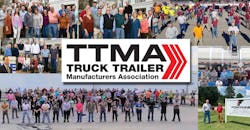For more than 75 years, the Truck Trailer Manufacturers Association has gathered for an annual convention, and Trailer/Body BUILDERS magazine has been there for the last 60 or so meetings. But 2020, thanks to social distancing and a travel shutdown due to the COVID-19 pandemic, is different.
So instead of a few days in April in San Antonio, TTMA President Jeff Sims and staff cobbled together a series of online meetings and presentations to keep members informed, to recognize the industry’s top safety performers, and to mark the comings and goings of association leaders.
And, in lieu of a formal passing of the chairman’s gavel and remarks from the dais about the state of the trailer industry past, present, and future, Sims organized a conference call for TBB with immediate past board chairman Bob Wahlin, president and CEO of Stoughton Trailers; and new chairman John Cannon, vice president, Regulatory and Industry Affairs, Wabash National Corp.
The conversation was duly wide-ranging, but the takeaway was clear: Trailer manufacturers still have plenty on the industry’s collective plate, even in an unprecedented global economic freeze.
“Everybody wants to cut when things get bad—and don’t get me wrong, there are going to be cuts everywhere when the industry is dropping more than 50% in production, year over year. But It wasn’t that long ago when manpower was the most significant issue, and it’s been that way for most of the last 10 years,” Wahlin said. “So I think the companies that are going to significantly advance coming out of this [downturn]—and in particular the trailer industry—are the companies that are going to have the stomach to continue to invest in people, and invest in their plants and equipment for automation. They are going to win.
“Now when I say invest in plants and equipment, I’m not talking about building more capacity. Our industry added too much capacity in the last several years, so we’re at over-capacity in general,” he continued. “I think that’s going to make the distinction between winners and losers even more significant, but those that are going to come out on the good side are those that invest in their people.
“They’ll look at the downturn as an opportunity to improve their plant equipment and processes, so they can be more efficient. They can drive that efficiency through the organization because [the market] will return; it will come back. And when it does, I think people are going to run into the same bottleneck of labor shortages, skills gaps, etc.”
On the Federal Excise Tax
One upside to the downside has been the potential for FET relief as part of a COVID-19 recovery package from Congress.
“It’s been floated to a great number of people on the hill, elected officials and all sorts of committees,” Sims said. “It seems like it might gain a little traction this time because it’s a temporary ask and not a permanent ask—that’s the biggest difference. We’re gathering some data now from all the trailer manufacturers: numbers of employees at the start of this year vs numbers of employees currently. We’re going to supply that to the [Modernize the Truck Fleet] coalition and just show the effects of what COVID has done.”
Cannon added: “As far as manufacturing is concerned, you take out that 12% and it completely changes the calculation for repair vs replace.”
Indeed, Sims cited a survey by the MTF coalition that reported 60% of carriers would be likely to purchase new equipment if the FET was not added to the cost.
Infrastructure bill
Speaking just days before Congress took a major preliminary step toward a highway bill reauthorization with an infrastructure package from House Transportation Committee (see Page XX), Cannon and Wahlin agreed that the nation’s roads need to be fixed—and now is the time.
“On the infrastructure bill, fortunately, both sides of the aisle are talking about it so it’s truly a bipartisan effort,” Cannon said. “It’s long overdue. Really, there has not been a substantial upgrade to the nation’s highways since Eisenhower was in office. This would allow for so many good jobs to be created and help the economy along—help the United States’ future economic competitiveness.”
Pointing to reduced congestion and emissions through the elimination of major highway bottlenecks, Cannon suggested that a good infrastructure bill would have bipartisan support for stimulus investment beyond any discussion of an increase in the federal motor fuels tax.
Wahlin added that he’s “confident” Congress will pass an infrastructure bill.
“The government is looking to provide a boost to the economy, so what better time to do something that they’ve been putting off for decades and is long overdue for investment?” Wahlin said. “There will be a lot of negotiation, but now’s as good a time as any.”
On changes to trailer standards
Highway reauthorization packages are often a means to work in needed transportation reforms, and while trailer length standards are not in the original proposal, changes would be a boon to trailer manufacturers.
“I do hope our government continues to consider the benefits for allowing a modest 5-foot increase to the existing length national standards for twin trailers from 28 feet to 33 feet,” Wahlin said. “That would encourage immediate manufacturing investments and bring meaningful benefits; particularly, the solution comes at no cost to the taxpayers and, theoretically, no revenue loss to the to the government.
“And the efficiency gains from allowing 33-foot twin trailers to operate across the national highway network were important before and will be after this health crisis.”
Citing data from Americans for Modern Transportation, a coalition of shippers and logistics providers, the 18% increase in trailer cube capacity would save $2.6 billion a year in shipper costs while also improving highway safety by reducing the number of vehicles on the road, Wahlin noted, calling it a “win nearly across the board.” He also voiced support for consideration of a 57-foot standard for van trailers and, “somewhere down the line,” an increase in gross vehicle weight limits where appropriate.
“This is something that’s good for our customers and could spark the trailer manufacturing industry—definitely,” Wahlin said.
GHG 2 litigation
At the time of this interview, TTMA was putting together its final brief answering the federal government’s response to the association’s legal challenge of the trailer requirements under the EPA/NHTSA Greenhouse Gas Emissions (GHG) and Fuel Efficiency Standards Phase 2.
Simply, the TTMA case—filed in December 2016—argues that EPA lacks authority under the Clean Air Act to regulate trailers as “motor vehicles” per the Clean Air Act. Enforcement of the trailer requirements had been in abeyance until late last year when TTMA opted to push for a court decision, given the EPA’s lack of progress in reconsidering the trailer portion of the standards.
Sims expects oral arguments in mid- to late summer and a fall decision.
“I’m expecting the best—that court would see it properly: [The government] overstepped their legal authority to regulate trailers under the Clean Air Act, and they should withdraw the trailer portion of both the NHTSA and EPA greenhouse gas rules,” Sims said.
Similarly, the California Air Resources Board has put a two-year hold on its GHG standards pertaining to trailers, given the limbo of the federal requirements. The state rules were to begin in January.
Sims suggested that trailer customers can feel secure in buying the correct equipment for the application, and he pointed to the EPA’s SmartWay program that encourages voluntary adoption of more efficient technologies as a successful government/industry effort.
“I think SmartWay has been the best path all along,” Sims said. “For over 12 years or so now SmartWay has had in place the measurement systems, the testing systems and certification process where device manufacturers can gather data and send it to them and be SmartWay approved.
“Then carriers, as they see fit and where needed, can purchase the equipment and have it installed—but it would be their choice. If a carrier buys 100 trailers and they know 80 of those are going to be on the road moving at highway speeds, they can opt to put the aerodynamic devices on those 80. So it’s carrier choice, where they get the ROI on that. Otherwise, to be forced to buy it for every trailer is just nonsense.”
Wahlin concurred.
“There’s a lot of concern with the greenhouse gas regulations, primarily putting on restrictions and adding costs to the product that may not be appropriate for how that particular product is used,” he said. “Right now, a lot of customers are relying on the information that’s coming from manufacturers. Some are being more proactive by putting options on their equipment that would get to those certification levels, but that comes at a cost that otherwise they may not have to absorb right now.”
And speaking of government/industry initiatives, Wahlin pointed to the development of more strict underride prevention standards as an area where “regulations that may cause harm in other ways” are possible if trailer manufacturers and end users don’t participate. (The House infrastructure package features a section on just such underride standards.)
“Some of these devices could increase the weight and then that means less cargo per trailer and more traffic on the road,” Wahlin said. “So just working together to get smart, realistic solutions and avoid some of the unintended consequences are key points and opportunities for government and industry collaboration.”
Looking down the road a bit, Wahlin also emphasized that standards need to be in place for implementing vehicle autonomy and other crash avoidance technologies, and the trailer aspect of the combination mustn’t be overlooked “so that everybody moves forward together and not in different directions.”
Connectivity standards
More immediate is the need for trailer connectivity standards to meet the load and equipment tracking demands of the modern supply chain. Both Cannon and Wahlin anticipate a basic uniformity that will support efficiency but still leave room for competition and innovation.
“We certainly think a standard is appropriate, and what is occurring at TMC [the ATA Technology and Maintenance Council] through the Smart Truck or Smart Trailer initiative is great. It shows a lot of promise, especially as it relates to the wired tractor and trailer.” Cannon said. “But we also think that there has to be an open industry protocol for a wireless solution so data can be harvested from that unit and from the different sensors that might be on that unit—harvested by the shipper, by the consignee, or by anybody else who should have access to that data so better decisions can be made.
“But we really hope it’s open, because so many of the different manufacturers of sensors have looked at having a proprietary type of approach. For the benefit of the end user, we really think it has to be an open-type architecture or an open API.”
Cannon pointed to Bluetooth technology as an available wireless protocol that could be used to connect to the various wireless sensors in a telematics system.
“The sensors could still be proprietary, but the data could be harvested in meaningful ways,” he said.
Wahlin explained that his company is taking such an approach.
“We’re not trying to make a Stoughton Trailer-specific telematics system,” he said. “It’s my belief that customers are going to want something that’s versatile—it’s not specific to one manufacturer. We believe that there’s going to be the need for flexibility to have the same option provided by multiple manufacturers, and we want to be able to provide the backbone for that system.”
Sims noted that TTMA is addressing the issue through its Engineering committee, and that most of the committee members are involved in the TMC effort, which also has a large carrier representation.
“We certainly will have to make sure that whatever TMC comes up with will work with the trailer,” Sims said. “We don’t want them to produce something that is impossible for us to do.”
TankFAX/TrailerFAX development
A cooperative project is underway between the government and transportation industry stakeholders to create a trailer history database, similar to the in-development TankFAX program to track cargo tanks, Cannon explained.
“It would be a benefit not just to government officials but also to manufacturers and other stakeholders for being able to get immediate information about a unit—be it a commerce decision, safety issue or what have you,” he said. “It certainly has the support of TTMA and the US DOT, and it’s my hope in the next year we’re able to get this trial started.”
Preliminary work is being done, but the package “still has a ways to go.”






